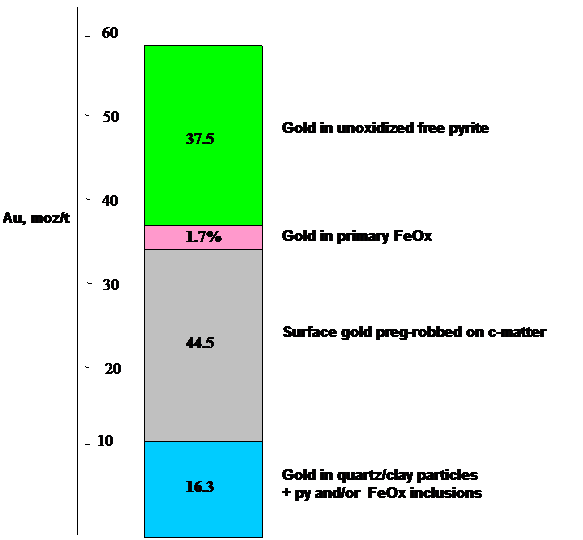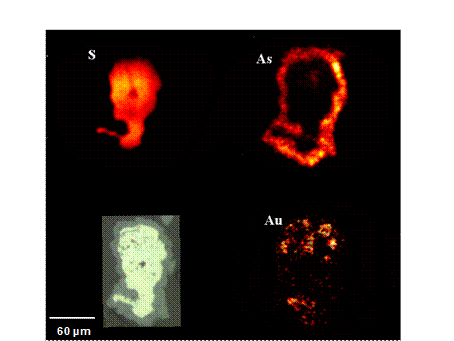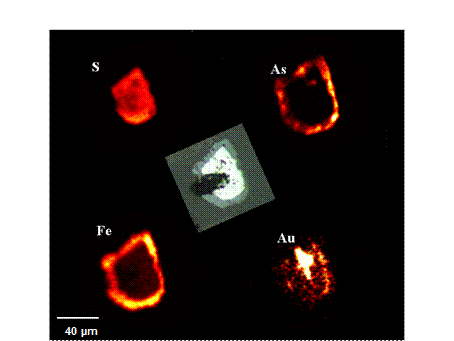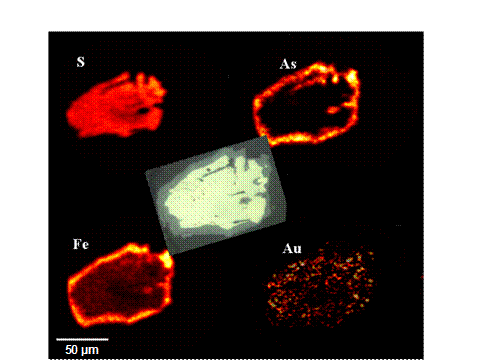Request for analysis:
A carbonaceous refractory sulphide ore is processed in an autoclave pressure oxidation plant and subsequently subjected to a cyanide leaching. An initial mineralogical study of the feed ore by quantitative dynamic SIMS analysis has shown that 95% of the gold is contained as sub-microscopic gold in pyrite with the remainder contained in primary Fe-oxide minerals. In addition, the feed ore contains a substantial fraction of carbonaceous material. The gold recovery is low and a gold deportment study of the CIL residue was requested in order to establish the gold distribution in the residue sample towards identifying the reasons for low recovery.
Objectives:
Methodology:
A standard procedure for gold deportment study in AC CIL residue is applied. It involves an independent quantification of sub-microscopic gold in different mineral carriers by dynamic SIMS and determination and speciation of surface gold preg-robbed on the carbonaceous matter present in the CIL residue by ToF-SIMS (For more details on these two techniques see the previous Application notes). The CIL residue was assayed for Au, As, S= and total carbonaceous matter (TCM) in triplicate, then sized by screening and gravity separated. The sized gravity tails was further processed to obtain a clean silicate fraction which was assayed for Au and S= content.
Results of the study:
The assayed values for sulphide sulphur, S=, indicated the presence of unoxidized pyrite in the CIL residue samples, which was confirmed by optical microscopy of polished sections. Different morphological types of pyrite grains were analyzed by dynamic SIMS and the amount of sub-microscopic gold contained in the unoxidized pyrite was determined using mineral-specific gold standards. Similarly, the sub-microscopic gold content in primary iron oxide minerals (hematite and goethite) was established. The ToFSIMS analysis of carbonaceous matter present in the residue determined the presence of preg-robbed surface gold in two different forms: metallic gold and Au(CN)2 compound.
The established deportment of gold in the CIL residue sample is shown in Figure 1. Figures 2-4 show D-SIMS distribution maps for Au, As, Fe and S in partially oxidized pyrite grains.
Major findings:
Two major causes for poor gold recovery were identified:

Figure 1. Gold deportment diagram for the CIL residue. The total assayed gold in the sample was 57 moz/t. The contribution of different gold carriers towards the gold losses is shown as a percentage of the total assayed gold value in the CIL residue sample.

Figure 2. Gold distribution in a rimmed, partially oxidized pyrite grain from AC POX/CIL residue. Note: Brighter colors correspond to higher concentration of the imaged element.

Figure 3. Gold distribution in a rimmed, partially oxidized pyrite grain from AC POX/CIL residue. Note: Optical microscope image taken after the SIMS depth profile analysis. The burned areas are the locations of the SIMS analysis at the oxide rim and the sulphide core.

Figure 4. Gold distribution in a rimmed, partially oxidized pyrite grain from AC POX/CIL residue.

